Copycat Recipes – McDonald’s French Fries
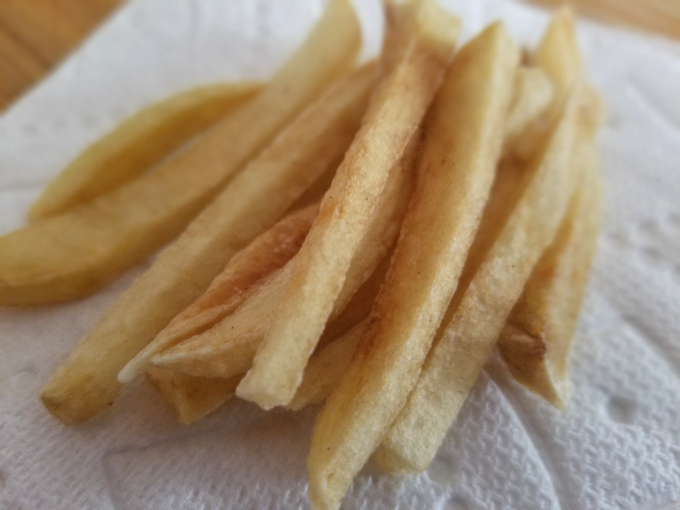
What is it about McDonald’s French fries that make them so addicting and ridiculously hard to put down? I think we can all agree they’ve got it figured out when it comes to fries. At least when it comes to the thin super crisp fries.
You know the kind I’m talking about too. The fries that are fresh out of the fryer, and borderline too hot to eat?
Yep, those are the ones.
And those are the ones we want to copycat here.
I’m going to apologize up front because this is going to be a long post. Apparently I have a lot to say about French fries. Now, this recipe does use a double fry, but it’s a bit different than your traditional type of double fry. For more about that, you can go here: Steak Fries
So with that being said, let me tell you how things usually go down when I go to McDonald’s.
It’s always the same, I get my order and pull out of the drive through. I tell myself I’m just going to eat a couple fries and save the rest for when I get home. But nothing every works out as planned.
I reach into the bag and grab about 6 fries, which by the way kind of burn my fingers. I then proceed to shovel them in my mouth, which also kind of burns. But that’s okay, I’m a grown man and I can take the pain.
I continue driving towards my destination, and before long I come to the sudden realization that I need another hit of fries. Like, I absolutely need another hit.
So the cycle continues until I pull into the driveway at home. Finally, I look into the bag and realize that I’ve eaten three quarters of my order of McDonald’s French fries. I shake my head in disgust at my complete lack of self-control, and remorsefully begin gathering up the stray fries (aka bonus fries) at the bottom of the bag.
Curse Those Millions of Dollars Spent in Research
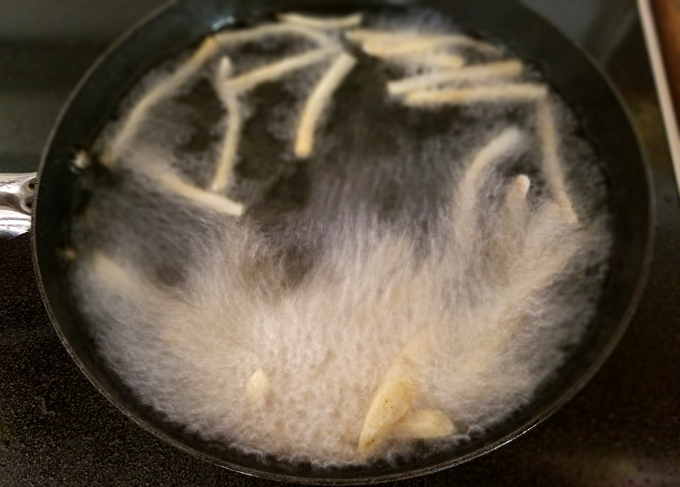
McDonald’s knows exactly what consumers want in a French fry. And I’d even wager that half the consumers themselves don’t even know or aren’t aware of what that is.
The quintessential McDonald’s French fry is uniform in shape, but can vary in length. It will always be the same color and will always have the same texture as every other French fry found in any other McDonald’s in America.
So then what is their secret for making those consistently delicious, light golden French fries so addicting?
Well there’s a few things we’ll have to figure out as we unlock the secrets behind Mcdonald’s French fries.
If you’ve ever taken a good look at a French fry from Mcdonald’s, you might have noticed some things. Here are the main things that stand out to me:
#1: They are all uniform in size
#2 They are all uniform in color
#3: The exterior of the French fry is crisp but not too crisp
#4: The interior of the French fry is soft and fluffy
We’ll be tackling each one of these step by step below.
#1: They are All Uniform in Size
McDonald’s French fries are notable for being very homogenized. That is too say, there isn’t much variance between one fry and the next.
Sure you might find the odd fry out once in a while, but for the most part, they’re all roughly 1/4″ inch (6.35 mm) on every side. This is important to note, because if the french fries aren’t sliced uniformly, we aren’t going to get a finished product that is the same across the board.
One French fry might have crisped up too much because it was much smaller than the other fries. Or maybe it doesn’t quite fully cook because it was simply cut too large. We just want to avoid all that.
McDonald’s has these cool machines that basically act like potato launchers. They rocket the peeled potatoes at around 75 mph (120 kph) straight into a grid of blades that slice the potatoes to the exact size we’re used to seeing at their restaurants.
I’m pretty certain when I say, that’s simply not an option for most people. At least it isn’t for me, I’m not rich.
So that means we have to get as close to that size as possible by other means. If you have a slicer that cuts potatoes you can use that, but you want to make sure you can get them as small as McDonald’s French fries.
I prefer to just use my Chef’s knife and cut them to the size I want. I’ll show you how to do that below.
Before you do any of this however, the potatoes need to be peeled and rinsed.
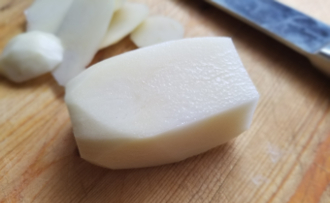
Some people might prefer to sort of square up the potato by slicing off the ends and the sides, like you see in the picture above. It’s personal preference though. I usually don’t do that.
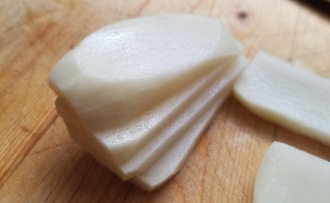
The most efficient way of cutting the fries, is to slice the potato lengthwise into roughly quarter inch slices. You can keep them stacked like this in preparation for the next step.
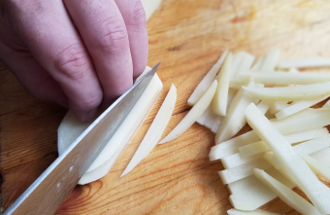
Square up the flat potato sections, and begin slicing your French fries in this manner, doing your best to maintain that quarter inch thickness.
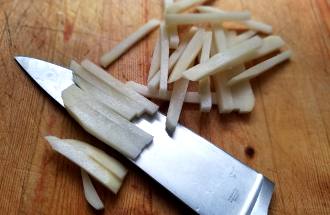
I’ve sliced a few fries and I’m ready for more.
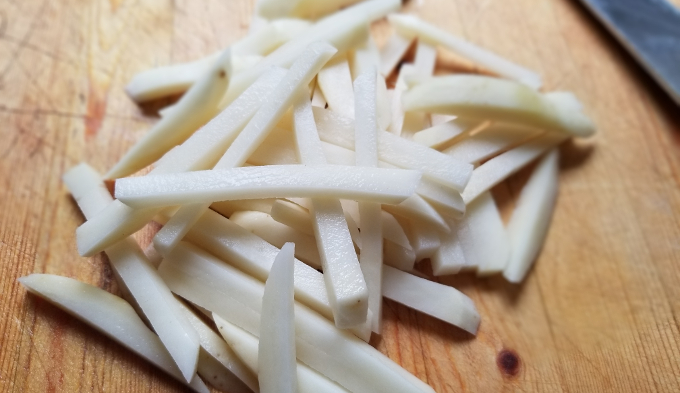
This is what the French fries should like after being sliced.
#2 They Are All Uniform in Color
When I say “They are all uniform in color” yes I’m talking about all the fries in an individual order, but I’m also talking about McDonald’s French fries in general. They’re always the same light golden color every time.
The method they use rarely changes. Everything is worked out and calculated. Cooking times are exact, and their whole French fry making process goes off like a well oiled machine. All the parts fit together perfectly from the beginning when the potatoes are peeled all the way to the final fry that takes place in the restaurants themselves.
My goal is to keep things as simple as possible. Or that is to say, I want to find a foolproof method that will work for everyone.
One thing I’ve noticed about McDonald’s French fries is that they’re light and crispy, but they don’t seem too oily to me. That’s another thing we want to make sure happens with our copycat fries.
#3: The Exterior of the French Fry is Crispy but not too Crispy
To achieve the crispiness levels that McDonald’s fries have, we need to make sure the surface of our fry is covered in tiny little air pockets. This is important for making your food not only crispy, but giving it a lighter texture.
If you’re curious as to where all those little holes might come from, I’ve got an answer. It’s a really long answer though, so I’m going to condense it as much as I can. It all boils down to the simple sugars, pectin, and starch that are in the potato and how they interact with each other.
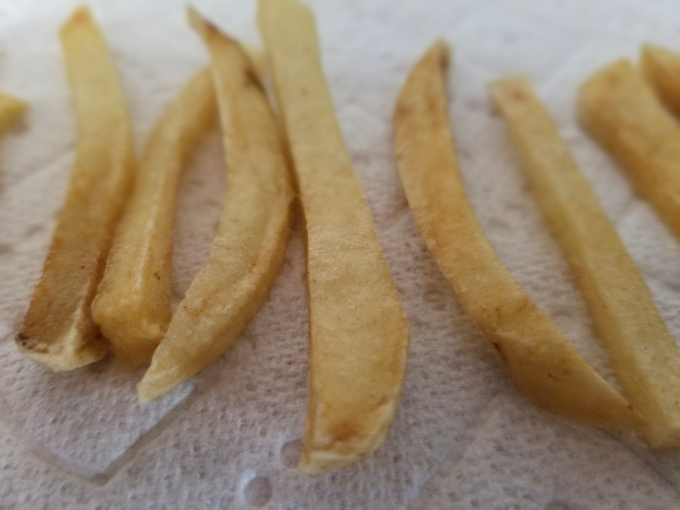
If you look closely at the picture, you can tell the surface of the French fry is riddled with tiny little bubbles or pores. That’s an important part of this whole process.
And after doing some research, I’ve learned that McDonald’s French fries go through a pre-fry blanching process. The French fries get sent on a trip through 170° F (76.6° C) water for about fifteen minutes.
This activates an enzyme called pectin methylesterase. Without sounding to sciency, this enzyme causes calcium and magnesium to reinforce the pectin’s hold on the cell walls of the potato. This allows the potatoes to stay stronger and more intact if and when cooked to a higher temperature.
Like most enzymes, pectin methylesterase is only active within a certain temperature range. When the ceiling of that range is reached, the enzyme shuts off completely. 170° F (76.6° C) is just under that ceiling. That’s the reason the fries go through a blanching process.
In conclusion, when the starches in the potato become hot enough and begin to burst, the potato’s cell walls stay strong. Instead of blistering into larger air bubbles as with a traditional double fry, the air bubbles remain much smaller.
Unfortunately, most people probably don’t have a piece of equipment to maintain water at exactly 170° F (76.6° C).
So we’ll be using a cooking thermometer to make sure the water stays close to the correct temperature. If you don’t have one, look on Amazon they seem to have everything.
#4: The Interior of the French Fry is Soft and Fluffy
We want to make sure the inside of the French fry ends up being fluffy and not gummy. That means that a good portion of the interior moisture needs to go. But how do we do that?
Here’s the rub. The more you cook the potato, the more the cell structures inside break down, making it easier for water to be expelled. And what better way to do that than to boil the potato?
But if you recall, the plan was to send the French fries through a pre-fry blanching at 170° F (76.6° C).
So we need to find a workaround. And I think I know what that is.
It was time for a little physics experiment.
First I heated up 1 quart (4 cups) of cold water in a medium sized stainless steel sauce pan until it reached 170° F (76.6° C). This was without fries, and it took just over 4 minutes.
Next, I repeated the process, but this time a added a handful of fries to the cold water. It took 4:45 minutes to reach 170° F (76.6° C). Unfortunately, after repeating this, I realized it actually went over the mark so I had to adjust the time down to 4:15 minutes to stay in the safe zone.
Once that threshold was reached I immediately killed the heat. I didn’t remove it from the burner, I simply turned it off.
After leaving everything on the burner for 10 minutes, I came back and checked the temperature, and to my surprise it hadn’t really gone down much.
I decided to wait another 10 minutes and see what happened. The next time I checked the water temperature, it had dropped by about 8 degrees overall.
So I drained the water and set the blanched fries on a wire rack to cool. Now it was time to heat the oil for the first fry.
If You Prefer Using a Deep Fryer, it Might Make Things Quicker
I heated the vegetable oil to 375° F (190° C) over medium-high heat, patted the fries with a kitchen towel to remove any excess water and put a handful of fries into the oil. It knocked the temperature of the oil down to about 350° F (170° C) but that was okay.
I fried them for exactly 3 minutes as the temperature of the oil began to rise again. That amount of time seemed to work well. But the proper initial frying time isn’t the only thing helping make the inside of the fry fluffier.
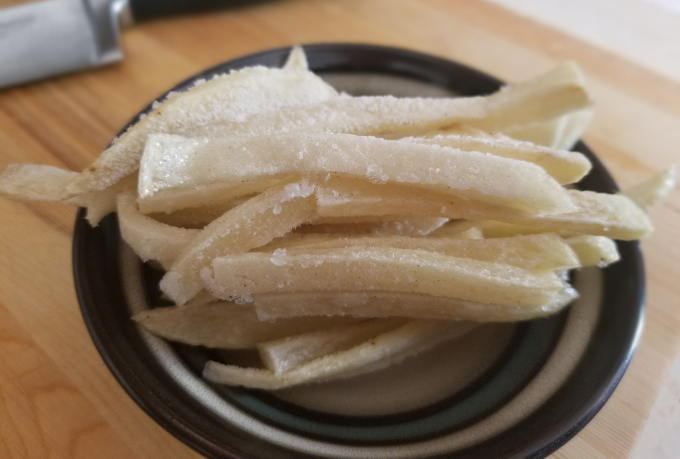
If you think about it, it’s very convenient how McDonald’s ships their French fries. Frozen.
I think we can take a page directly from their playbook and do the same thing. Not only is it convenient for shipping, but it also plays an important role in forming that fluffy interior we’re looking for.
Here’s the idea behind why freezing them is just another step we can take towards recreating McDonald’s French fries. Freezing the potatoes causes the moisture inside to turn to ice. This ice consists of crystals which are jagged and sharp.
I think you can see where I’m headed with this…
The ice crystals damage the cell structure of the potato, making it easier for the moisture to escape via steam when the potatoes are thrown into hot oil.
Here’s the best part of the whole thing. Since we need to freeze them before doing our final fry, we can blanch them and do our initial fry in large quantities. Then we can separate them into batches and put them in the freezer.
By doing this, you’ll have a nearly endless supply of French fries that are ready to go in the fryer anytime you get the craving for some McDonald’s French fries.
The Final Fry
The second deep fry is super quick and should only be enough to turn the outside of the French fry a nice but light golden color. Just like you see at McDonald’s.
Since the fries are cut small to begin with, they don’t need very much time in the oil to finish cooking.
Basically, I heated the vegetable oil over medium-high heat again until it reached 400° F (205° C). I then removed one of the bags of fries from the freezer, removed them from the bag, and carefully lowered the fries into the oil.
Be very careful with this part. Since the oil is very hot at this point, it’s going to react rather aggressively with the frozen French fries. It will likely splatter a little.
My advice is to make sure the pot isn’t too full of oil. The French fries are small so you don’t need to go overboard with the amount of oil you’re using.
Simply drop them in the oil for exactly 1 minute and then remove them to dry. You should end up with perfectly cooked French fries that look and taste just like what you’d get at a McDonald’s. Don’t forget to toss some salt on them before serving.
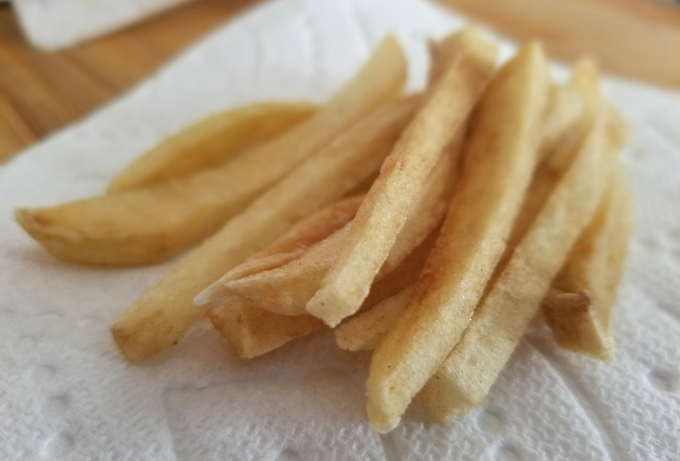
Copycat Recipe – McDonald’s French Fries
By: Semiserious Chefs
Serves: 2 – 4
Ingredients:
- 4 medium – large russet potatoes
- Oil for frying
- Salt (to taste)
Directions:
- Peel potatoes, and discard the skin.
- Begin slicing the potatoes lengthwise as shown above into 1/4″ inch thick slices. Place the slices on their side and square them up. Begin cutting 1/4″ inch wide French fries as shown in the pictures above and place them in a large bowl of cold water.
- In a medium sauce pan add 4 cups (1 quart) cold water and a handful of French fries. Place over high heat until the water reaches just under 170° F (76.6° C). Be vigilant with your thermometer. It took 4:15 minutes for me to reach that point.
- Once it reaches that temperature, immediately turn off the heat and set a timer for 20 minutes. That’s how long it should soak in the hot water for. Remember, this is to reinforce the pectin’s hold on the cell walls of the potato so the outside holds up better during the two frying stages.
- After 20 minutes, drain the water and place the blanched French fries on a wire rack or paper towel-lined cooking sheet.
- Heat vegetable oil over medium-high (this is important) heat until it reaches 375° F (190° C). Let the French fries cook for exactly 3 minutes. Transfer them to a wire rack so they can cool, and the excess grease can run off.
- Once cool, place French fries in batches into freezer bags and put them in the freezer. They should stay in the freezer for a minimum of two hours. Longer is ideal.
- When ready to make your copycat McDonald’s French fries, heat vegetable oil to 400° F (205° C), over medium-high heat and drop frozen fries a handful at a time into the oil. Cook for exactly 1 minute. The oil will probably drop to around 375° F (190° C), but that’s normal.
- Transfer fries to wire rack to dry.
- When ready to serve, place them in a bowl and toss with some salt.

